Green Functions¶
Module: pycsou.math.green
Green functions of common pseudo-differential operators.
Classes
|
Causal Green function of \((D+\alpha\mbox{Id})^k\). |
Causal Green function of the iterated derivative \(D^k\). |
|
|
Matern function for \(k\in\{0,1,2,3\}\). |
|
Sub-Gaussian function. |
|
Wendland functions for \(k\in\{0, 1, 2, 3\}\). |
-
class
Matern(k: int, epsilon: float = 1.0)[source]¶ Bases:
objectMatern function for \(k\in\{0,1,2,3\}\).
Examples
import matplotlib.pyplot as plt import numpy as np from pycsou.math.green import Matern x=np.linspace(-3,3,1024) for k in range(4): matern=Matern(k) plt.plot(x, matern(np.abs(x))) plt.legend(['k=0', 'k=1', 'k=2', 'k=3'])
(Source code, png, hires.png, pdf)

Notes
The Matern function is defined in full generality as ([GaussProcesses], eq (4.14)):
\[S_\nu^\epsilon(r) = \frac{2^{1-\nu}}{\Gamma(\nu)}\left(\frac{\sqrt{2\nu} r}{\epsilon}\right)^\nu K_{\nu}\left(\frac{\sqrt{2\nu} r}{\epsilon}\right), \qquad \forall r\in\mathbb{R}_+,\]with \(\nu, \epsilon>0\), \(\Gamma\) and \(K_\nu\) are the Gamma and modified Bessel function of the second kind, respectively. The parameter \(nu\) determines the smoothness of the Matern function (the higher, the smoother). The parameter \(epsilon\) determines the localisation of the Matern function (the higher, the more localised). For \(\nu\in\mathbb{N}+1/2\) the above equation simplifies to:
\[S_{k+1/2}^\epsilon(r)=\exp\left(-\frac{\sqrt{2\nu} r}{\epsilon}\right) \frac{k!}{(2k)!} \sum_{i=0}^{k} \frac{(k+i)!}{i!(k-i)!}\left(\frac{\sqrt{8\nu}r}{\epsilon}\right)^{k-i}, \qquad \forall r\in\mathbb{R}_+,\]with \(k\in \mathbb{N}\). This class provides the Matern function for \(k\in\{0,1,2,3\}\) (Matern functions with \(k>3\) are nearly indistinguishable from a Gaussian function with standard deviation \(\epsilon\)). The Matern radial basis function \(S_{\nu}^\epsilon(\|\cdot\|)\) in \(\mathbb{R}^d\) is proportional to the Green function of the pseudo-differential operator \(\left(\mbox{Id} - \frac{\epsilon^2}{2\nu}\Delta_{\mathbb{R}^d}\right)^{2\nu+d}\), i.e. \(\left(\mbox{Id} - \frac{\epsilon^2}{2\nu}\Delta_{\mathbb{R}^d}\right)^{2\nu+d}S_{\nu}^\epsilon(\|\cdot\|)\propto \delta\).
See also
-
class
Wendland(k: int, epsilon: float = 1.0)[source]¶ Bases:
objectWendland functions for \(k\in\{0, 1, 2, 3\}\).
Examples
import matplotlib.pyplot as plt import numpy as np from pycsou.math.green import Wendland x=np.linspace(-1,1,1024) for k in range(4): wendland=Wendland(k) plt.plot(x, wendland(np.abs(x))) plt.legend(['k=0', 'k=1', 'k=2', 'k=3'])
(Source code, png, hires.png, pdf)
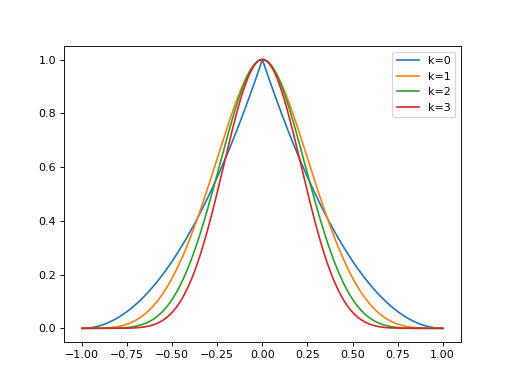
Notes
Wendland functions are constructed by repeatedly applying an integral operator to Askey’s truncated power functions. They can be shown to take the form:
\[\phi_{d,k}(r)=\left(1-\frac{r}{\epsilon}\right)_+^{l + k} p_{k,l}(r),\qquad r\in\mathbb{R}_+,\]where \(l=\lfloor d/2\rfloor+k+1\), \(a_+=\max(a,0)\) and \(p_{k,l}\) is a polynomial of degree \(k\) whose coefficients depend on \(l\). These functions are compactly supported piecewise polynomials with support \([0,\epsilon)\) which yield positive definite radial kernels in \(\mathbb{R}^d\) with minimal degree and prescribed smoothness.
This class provides an implementation of Wendland functions using the closed-form forumlae in [FuncSphere] Figure 8.2 for \(k\in\{0, 1 ,2 ,3\}\).
See also
-
class
CausalGreenIteratedDerivative(k: int)[source]¶ Bases:
objectCausal Green function of the iterated derivative \(D^k\).
Examples
import matplotlib.pyplot as plt import numpy as np from pycsou.math.green import CausalGreenIteratedDerivative x=np.linspace(-1,1,1024) for k in range(1,5): green=CausalGreenIteratedDerivative(k) plt.plot(x, green(x)) plt.legend(['k=1', 'k=2', 'k=3', 'k=4'])
(Source code, png, hires.png, pdf)
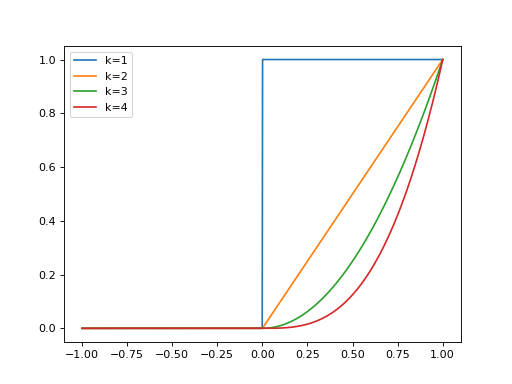
Notes
The Green function \(\rho_k\) of the iterated derivative operator \(D^k\) on \(\mathbb{R}\) is defined as \(D^k\rho_k=\delta\). It is given by: \(\rho_k(t)\propto t^{k-1}_+\).
See also
-
class
CausalGreenExponential(k: int, alpha: float = 1)[source]¶ Bases:
objectCausal Green function of \((D+\alpha\mbox{Id})^k\).
Examples
import matplotlib.pyplot as plt import numpy as np from pycsou.math.green import CausalGreenExponential x=np.linspace(-1,5,1024) for k in range(1,5): green=CausalGreenExponential(k) plt.plot(x, green(x)) plt.legend(['k=1', 'k=2', 'k=3', 'k=4'])
(Source code, png, hires.png, pdf)
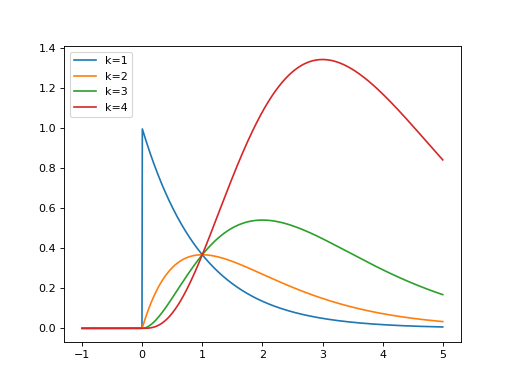
Notes
The Green function \(\rho_k\) of the 1D pseudo-differential operator \((D+\alpha\mbox{Id})^k\) on \(\mathbb{R}\) is defined as \((D+\alpha\mbox{Id})^k\rho_k=\delta\). It is given by: \(\rho_k(t)\propto t_+^{k-1}e^{-\alpha t}\).
See also
-
__init__(k: int, alpha: float = 1)[source]¶ - Parameters
k (int) – Exponent \(k\) of the exponential pseudo-differential operator \((D+\alpha\mbox{Id})^k\) for which the Green function is desired.
alpha (float) – Strictly positive parameter \(\alpha\) of the exponential pseudo-differential operator \((D+\alpha\mbox{Id})^k\) for which the Green function is desired.
-
-
class
SubGaussian(alpha: float, epsilon: float = 1.0)[source]¶ Bases:
objectSub-Gaussian function.
Examples
import matplotlib.pyplot as plt import numpy as np from pycsou.math.green import SubGaussian x=np.linspace(-3,3,1024) lg=[] for alpha in np.linspace(0,2,6)[1:-1]: subgaussian=SubGaussian(alpha) plt.plot(x, subgaussian(np.abs(x))) lg.append(f'$\\alpha={np.round(alpha,1)}$') plt.legend(lg)
(Source code, png, hires.png, pdf)
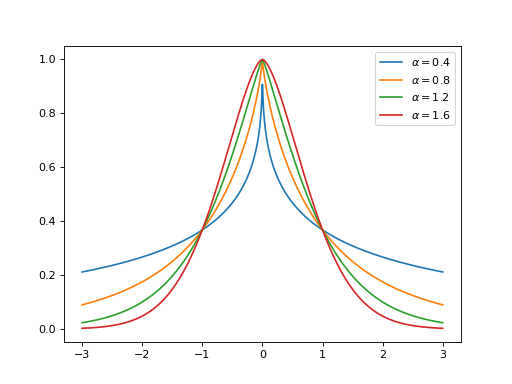
import numpy as np import matplotlib.pyplot as plt from pycsou.linop.sampling import MappedDistanceMatrix from pycsou.math.green import SubGaussian t = np.linspace(0, 2, 256) rng = np.random.default_rng(seed=2) x,y = np.meshgrid(t,t) samples1 = np.stack((x.flatten(), y.flatten()), axis=-1) samples2 = np.stack((2 * rng.random(size=4), 2 * rng.random(size=4)), axis=-1) alpha = np.ones(samples2.shape[0]) ord=.8 epsilon = 1 / 12 func = SubGaussian(alpha=ord, epsilon=epsilon) MDMOp = MappedDistanceMatrix(samples1=samples1, samples2=samples2, function=func, ord=ord, operator_type='dask') plt.contourf(x,y,(MDMOp * alpha).reshape(t.size, t.size), 50) plt.title('Sum of 4 (radial) sub-Gaussians') plt.colorbar() plt.xlabel('$x$') plt.ylabel('$y$')
(Source code, png, hires.png, pdf)
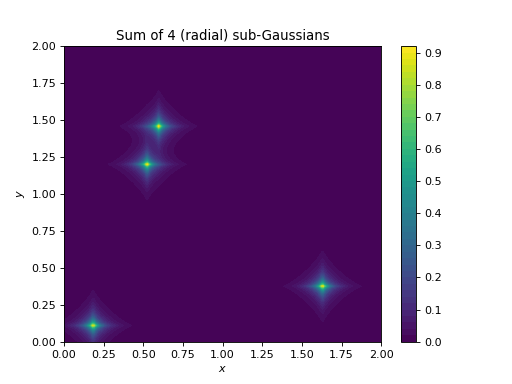
Notes
The sub-Gaussian function is defined, for every \(\alpha\in (0,2)\) and \(\epsilon>0\), as:
\[f_\epsilon(r)=\exp\left(-\frac{r^\alpha}{\epsilon}\right), \qquad r\in \mathbb{R}_+.\]It can be used to build sub-Gaussian radial kernels [SubGauss], which are known to be positive-definite and their inverse Fourier transforms (the so-called α-stable distributions) are heavy-tailed and infinitely smooth with algebraically decaying derivatives of any order.